- Office Directory
- Hotline Numbers
EDUCATION

Mandaluyong is host to a number of various public and private educational facilities that provide for the schooling needs of the city’s populace.
Private School Facilities
There are 27 private schools in the city which accommodate both local students and those coming from neighboring cities and municipalities as well as the nearby provinces. Prominent among the private schools are the La Salle Greenhills and two (2) universities, the Jose Rizal University and the Rizal Technological University, the latter being a semi-government institution (Map 47).
There are also a variety of computer schools which offer short-term as well as complete computer courses and college degrees. A number of vocational and technological schools offer curricular programs in trade and industry, home-making and business and commerce.
Public School Facilities
Public education facilities comprise 16 elementary schools, and with the addition of the Andres Bonifacio Integrated School which started operation in SY 2002-2003, there are now five (5) secondary schools which cater to Mandaluyong residents.
The spatial distribution of public schools (Map 48) reveals that the city is indeed sufficiently provided with public educational facilities.
School compounds are efficiently situated within walking distance of 0.5 km. to 1.0 km. from its respective service areas, free from hazardous crossroads and heavy traffic. Accessibility is made easier by the presence of motorized tricycles for hire.
There are, however, other factors (e.g. enrollment, school going-age population, and the actual number of classrooms and teachers, and others) that must be considered in order to assess efficiency of public education services in the city, such as:
Teacher-Student-Classroom Ratio
Public elementary schools vary in sizes from a small 5-classroom school facility to as large as 86-classroom school facility (Table 5.01), giving an aggregate of 532 classrooms as of SY 2003-2004. The three largest schools are Mandaluyong Elementary School (86 classrooms), Eulogio Rodriguez Elementary School (68 classrooms), and Highway Hills Elementary School (59 classrooms), each one housing a district office of the Division of City Schools-Mandaluyong City.
In the secondary level, Mandaluyong High School (Main) has the largest facility with 55 classrooms, while the city’s Science High School is the smallest with only 28 classrooms. This gives an aggregate of 196 secondary classrooms for SY 2003-2004.
All in all, at the latest, student-classroom ratios reach an average of 1:50 and 1:67, respectively, for elementary and secondary levels (Table 5.02). Such high ratios indicate the need for more classrooms especially in the secondary level, which, at present, is being addressed by having morning and afternoon class-shifts with the latter even extending up to 8:00 o”clock to 9:00 o”clock in the evening.
However, there are a sufficient number of public school teachers, with teacher-student ratios averaging to 1:36 and 1:32 in the elementary and secondary levels, respectively, which are still above the standard ratio of 1 teacher for every 40 students.
Performance Indicators
Table 5.04 shows declining performances particularly the cohort-survival rates and completion rates. A considerable percentage of drop-outs for the elementary level is recorded raging from a low of 4.9 percent in SY 2000-2001 and leveling at 5.23 percent for the succeeding years. The secondary level registered a higher turn-out of drop-outs recorded at 7.76 percent, 9.26 percent and 8.78 percent respectively for the last three (3) school years. This may be attributed to the following reasons:
-Lack of financial capability to cover transportation expenses and cost of school supplies and other requirements
-Poor study habits due to lack of home supervision
-Lack of motivation
-Media influence
-Peer pressure
-Transfer of residence due to unavoidable circumstances
Enrollment in all levels continuously increased during the last three schools years with the year 2002-2003 (Table 5.05) having the highest registered number of students pegged at 41,679. There was considerable decrease of enrollment for the following school year (2003-2004) which registered 39,815 students only.
However, the recent NSO results (Table 5.06) yielded high level of overall literacy among residents. Overall literacy rate is pegged at 99 percent with exactly one percent belonging to the illiterate group.
HEALTH
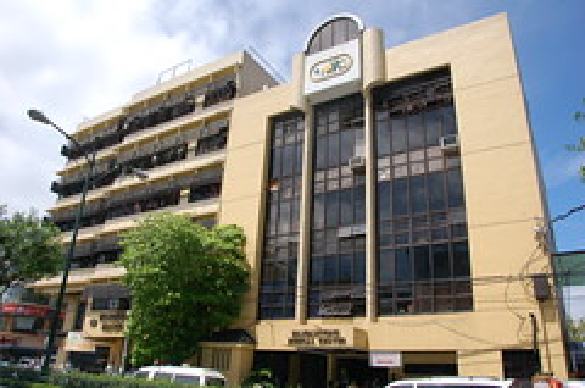

Mandaluyong is host to a number of public and private health facilities that provide for the health care needs of the city’s populace.
The City Medical Center and other Private Tertiary Hospital
Curative health services are provided by one (1) public and three (3) private hospital facilities (Table 5.07). This is excluding the specialized facility for mental health being provided by the National Center for Mental Health in Welfareville Compound.
The Mandaluyong City Medical Center (MCMC) is the only government hospital of the city that provides for tertiary level health services to local constituents. It is currently in its final phase of completing its physical expansion that will generate additional bed capacity and much improved facilities.
MCMC has a total manpower of 375 consisting of 116 medical professionals, 38 ancillary personnel, 120 nurses and nursing aides, and 101 civilian employees. The five-floor hospital structure has an existing bed capacity of only 105. However, the completion of the annex building will expand its bed capacity to 300 and will house the following sections:
-Surgical ward, medicine office, Office of the Head Nurse
-Medicine Wards, Reception, Social Welfare, Surgical Office
-OB ward/ OB Gyne Office
-Storage Room
-Emergency Areas, OR Support Rooms
-Central Storage and Sterilization Room
To ensure exclusivity of medical services, local residents are being encouraged to avail of the “Manda Card” currently being issued by the MCMC. However, it still remains hospital policy to serve all in dire need of medical attention especially in times of emergency. Table 5.08 outlines the MCMC Services and facilities as available per floor level.
The Local Health Centers
Resources, Facilities and Services
Twenty-six (26) health centers scattered in various barangays provide local health services to the city residents. Ten (10) of these health centers are certified by the Department of Health (DOH) as “Sentrong Sigla” centers, which means that these centers have passed stringent evaluation criteria on quality health servicing. Generally, all health centers provide preventive health services such as general medical services, dental and optical service, laboratory services, nutrition supplements and immunization programs.
These health centers, listed in Table 5.09, are under the administrative and technical supervision of the City Health Office whose responsibilities extend to continuous monitoring of water supply and ensuring public access to safe water and promoting the use of sanitary toilet facilities particularly in depressed areas.
Specifically, the city health centers focus on three major health programs/services: Family Health, Infectious Disease Control, and Prevention and Control of Non-Communicable Diseases. Summary of activities under these services is listed in the proceeding table (Table 5.10).
Two (2) Lying-in clinics provide supplementary health service to mothers. Their services include: attendance to normal deliveries, referrals of all cases with complications to hospitals, newborn screening and care, and breastfeeding.
The average number of patients served daily ranges from 20 to 70 persons per health center depending on the location and area coverage. (Table 5.11).
Each of these centers has a complete compliment of at least one (1) physician, one (1) or two (2) nurses, two (2) or more midwives, a dentist, a dental aide, a laboratory aide, a nutritionist, Barangay Nutrition Scholars and Barangay Health Workers.
Total government expenditure on health services (City Health Budget) amounts to seven percent (7 %) of the overall city budget for the year 2002.
Spatial distribution of health facilities is shown in Map ~ Health Facilities.
Causes of Mortality and Morbidity
Consolidated reports from the City Health Office and hospitals reveal a total of 7,106 live births delivered in year 2002 giving a crude birth rate of 23.99% for every 1000 population, slightly higher than a CBR of 22.74 in 2001.
Crude death rate has been increasing at 3.35, 3.5 to 4.0 for the years 2000, 2001, and 2002, respectively (see Table 5.13a; Table 5.13b; Table 5.13c; Table 5.13d) for causes of death by specific age group.
Infant mortality increased by more than 2% from 14.87% in 2001 to 17.03% in 2002 with prematurity as the top most cause of death followed by pneumonia. There is, however, no recorded incidence of death among women in pregnancy, labor and post partum in 2002 as compared to the previous years wherein Abrupto Placenta was often the cause of death.
For all ages, on the other hand, Cerebro Vas Acc. and Pneumonia have been consistently the two (2) leading causes of deaths as reported by the MCMC for the years 2000, 2001, and 2002. The CHO likewise reported Pneumonia as the leading cause of death, along with Myocardial Infarction and Cancer.
Deaths due to epidemic occurrences such as dengue, leptospirosis and typhoid fever had been controlled in 2002 although there were several cases of individual affected by such diseases. Cases of measles reduced considerably in 2002. Unfortunately, there are still cases of deaths even in the current year despite intense efforts of the city health officials to cover every local household in the government’s measles prevention program.
Evidently, lack of cooperation on the part of the residents mostly in depressed areas is the main culprit in this failure to eradicate measles in the city. This February, the City Health Office once again actively participated in the nationwide campaign against measles by deploying teams of health personnel to provide immunization shots to children below eight (8) years old, covering all households, day care centers and schools as well.
Incidence of common disease for children 0-4 years old and patients of all ages are shown in Tables 5.14a; Table 5.14b; Table 5.14c.
For other health concerns, the 2002 record shows a General Medical Consultation Rate of 34 and 278 for city health centers and the Mandaluyong City Medical Center, respectively. In addition, MCMC recorded an annual hospitalization rate of 33 with a total hospital admission of 9,650 in 2002. Compared with the health centers (Table 5.11), MCMC serves an average of over 250 patients daily, decreasing at 313, 274 and 252 in 2000, 2001, and 2002, respectively.
Degree Of Malnutrition
With the objective of monitoring the nutritional status of children under seven (7) years old and at the same time provide adequate intervention in the problem on malnutrition, the City Health Office conducts annual weighing of children in this age group through the Operation Timbang Project. A summary report of this project is presented in Table 5.15.
As expected, Brgy. Addition Hills has considerably the largest number of children suffering from 2nd and 3rd degree malnutrition. This, however, is primarily due to the fact that this barangay is the most populated and at the same time site of the largest informal settlement in the city. Moreover, intensive efforts to address this situation resulted to about 50 percent reduction in the number of cases from 2000 to 2002.
While a regional evaluation on nutrition services puts the city of Mandaluyong among those with very low performances, it is recognized that this may be due to poor documentation of the city’s accomplishments. In fact, such accomplishments were highly commended during the latest advocacy meeting between the city government and the National Nutrition Council.
As a consequence, the City Nutrition Committee is reactivated involving more local government offices to facilitate, coordinate and properly document delivery of nutrition services to the community. In addition, Barangay Nutrition Committees are formed to ensure proper adoption and implementation of the National Nutrition Program at the barangay level.
Family Planning
Focusing on gender sensitively and reproductive health, the City Health Office has continuously put intensive efforts to promote the use of various family planning methods to local couples.
Inspite of this, there are no significant changes in Contraceptive Prevalence rates for the years 2000 to 2002 (Table 5.12). However, recruitment of new acceptors and maintenance of continuing users (Table 5.16 & Table 5.17) show relatively good results in most barangays.
SOCIAL SERVICES
Social Welfare services in Mandaluyong are provided by 14 different agencies; 6 from the government sector, and 8 are non-government organizations. (see Table 5.23).
Among the government agencies, two have citywide areas of coverage:
The Local Division of Social Welfare and Development which provides comprehensive social services, and is staffed with 50 Social Workers and with office located at the City Hall Compound. The Integrated Day Center which serves special children and normal children in the 0-3 years age bracket. The other four (4) agencies have nationwide coverage serving women detainees/prisoners and the mentally ill and recovered psychotics. These agencies are located within the Welfareville Compound, a 116 hectare property of the Department of Social Welfare and Development strategically located at the center of the city.
The non-government organizations are mostly associated with the religious sector, serving the needs of street children and the needy youth, as well as outreach activities and ministries to the needy parishioners. Locations of these service organizations are shown in Map 53.
Disabled Persons Affairs
Formerly a program of the CSWD, the Disabled Persons Affairs has evolved into a new division under the office of the City Administration through City Ordinance No. 193.S-1998. Since then, DPAD has developed sustaining programs which had reached hundreds of special children and differently-abled persons over the past couple of years. Among these programs are on research, education, advocacy, accessibility, community-based programs and organization, sports and socio-cultural programs, employment and livelihood, as well as income generation programs
Research
Included in the program is the development/upgrading of the data base of persons with disabilities, linkage with research centers for possible research-based programs, and publication of wall news, journals, newsletters and other information materials for the service of the sector.
Education
This provides the literacy program of the sector through evaluation of the present educational system for children and youth with disabilities, and establishment of institutions for programs that will help uplift the educational capability of beneficiaries.
Advocacy
This includes lobbying for support through the City Council for the passage of support local legislations for the sector; development of barangay, school-based and church-based awareness program; and, development of family, community and workplace sensitivity workshops.
Accessibility
This works for the establishment of a task force to monitor the implementation of the Accessibility Law and the Magna Carta for Disabled Persons.
Community-based Program and Organization
Support the establishment of different organizations of persons with disabilities and caregivers.
Sports and Socio-cultural Program
Development of sports training, linkage with both local, national and international sports association and participation in such sports events; institutionalization of different sporting events in the city’s programs; development of theater group composed of the sector.
Employment and Livelihood
Development of employment programs for the sector and linkage with other agencies for the promotion of the sector’s employment and livelihood concerns, as well as establishment of cooperatives.
Income Generation
Full implementation of the programs means support from other sources, not just the local government. DPAD tries to see to it that programs could be sustained at minimal costs of the local administration. This, DPAD tries to manage through networking with other concerned private organizations.
To date, thousands of disabled persons in the city has been benefited by the DPAD programs since it started six years ago. Table 5.24 shows the summary of projects and its impact to the sector.
Livelihood and Skills Development
From a small government institution, the Mandaluyong Manpower and Development Center (MMDC) has evolved into nationally competitive training center operationally guided by the philosophy of helping man realize his optimum potential to be a profitable member of his community. To develop and enhance capability and competencies of the unemployed, underemployed and those tending to be entrepreneurial, the MMDC as a training institution offers free training in various vocational and technical courses as well as livelihood programs. (See Table 5.25)
The center has two (2) training centers, one in Barangay Hulo and another at Welfareville Compound in Addition Hills. It has a total of 23 training facilitators and 26 support staff, supported by budget allocations from the General Fund.
A new addition to the center’s roster of courses is Carpentry. Its initial project, the Casket Making, catered to handicapped trainees whose training expenses were shouldered by the city government. These caskets were in turn sold for a minimum fee to the needing poor families in the city. This project has significant benefits both to the consumers of the affordable caskets as well as to the handicapped makers who eke out their living from the new craft.
As a placement and counseling office
The MMDC also give guidance counseling and placement assistance. Aside from PESO, MMDC through its Placement Officer conducts Training Induction Programs (TIP) and Job Induction Programs (JIP) for the on-going and out-going trainees. These orientations are conducted to promote study habits, moral, attitudinal and work values and ethics of training beneficiaries. The center also provides a listing of employment opportunities and makes job referrals to both public and private sectors.
Target participants of the livelihood programs of the MMDC are city residents from the poor barangays. Advocacy on the importance of education is its focus through career guidance in all public elementary and secondary schools in the city.
As a service-oriented entity
The MMDC conducts trade tests in various trade areas to out-going trainees in order to determine their effectiveness in skills by theories and practical applications and to upgrade their qualification for employment. The trade test is administered by testing officers from the TESDA-NCR-PaMaMariSan District.
Entrepreneurial initiatives are also a regular program of the center especially for the out-of-school youths and the unemployed adults. Seminars are conducted regularly by TESDA and other private agencies. These seminars aim to assist beneficiaries to get into employment through industry or self-employment.
Awards and Recognitions
For the past three years, the center has earned awards and recognition for both the center and its exemplary trainors and students which include the following:
-Certificate of Recognition for the Center for achieving 130% of its target on Basic Skills and Livelihood Training Program
-Outstanding Training Center Achievement Award from TESDA
-Most Outstanding Training Administrator in Metro Manila
-First Place, Pres. Ramon Magsaysay Working Man Award for the NCR Level
-Silver Medalist, Metro Manila 1997 Youth Skills Olympics
-First Place, 1999 Regional Skills Olympic Welding competition
-Silver Medalist, Welding Competition, Philippine National Skills Competition
-2000 National Awardee of “TESDA KABALIKAT AWARD” for the City Government
-2002 Outstanding Training Achievement Award for outstanding performance in the conduct of community-based technical and --skills training by graduating over 1,000 trainees for the year
-Special Citation Award for its promotion of TESDA Occupational Qualification and Certification System (TOQCS)
-Certificate of Recognition for its valuable contribution in the promotion and conduct of community-based technical skills training
-Outstanding Industrial Skills Trainor Award to Arc Welding trainor Mr, Bernardo A. Benito for his outstanding performance and --selfless contribution and dedication to the technical, moral and spiritual development of the trainees
-Certificate of Recognition Award to Ms. Rebecca O. Villaflores (Cosmetology/Reflexology Trainee) for having shown exemplary performance in relation to her technical and skills training
To promote specific trade areas and occupations relevant to present economic trends and gain active participation of the industry in advocating skills excellence, the Center launched its First Mandaluyong Open Skills Competition on July 15, 1999, and has continued to do so every year since then.
PROTECTIVE SERVICES

he Philippine National Police Headquarters, Station 3 is located within the City Hall Compound, housed in a four-level building complex together with the local Fire Department and the City Jail. Its area of jurisdiction covers the entire City of Mandaluyong.
For a more efficient delivery of protective services, five (5) community precincts (Table 5.26) are established in strategic locations in the city, each covering a different group of barangays, as can be seen in Map 54. Each precinct is provided with well-maintained service vehicles and equipment as listed in Table 5.27.
Manpower
Total size of the police force is 301, composed of 265 non-commissioned officers, 20 officers and 16 civilian employees. This gives a police-population ratio of 1:925 which is below the standard for highly-urbanized areas.
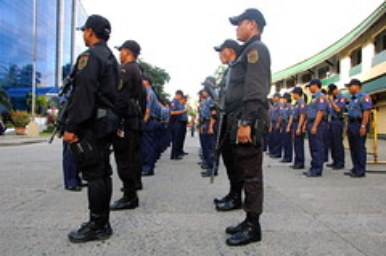
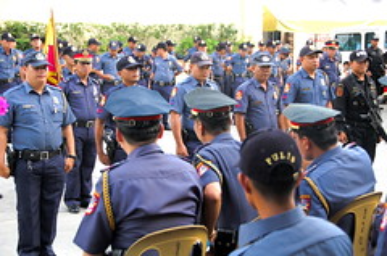

The force is augmented by 489 civilian employees under the Public Order and Safety Division and the Mayor’s Action Command of the city government.
In addition, the Force has accredited a total of 34 private agencies that provide private security and detective services. These are listed in the proceeding Table 5.28.
Crime Statistics
Report from the Philippine National Police reveals that the city enjoys a relatively peaceful community. Crime Solution Efficiency for the past four years registered a high of 96.39% in year 2000 and a low of 94.31% for the current year. The figure for the current year however, is only inclusive of January to May 2003. Theft and physical injury are among the top index crimes committed in the city.
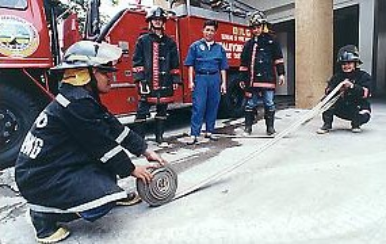
A. Building Resources
Mandaluyong Fire Station The city is protected from fire incidences by the Mandaluyong Fire Station, with its Head Office and Central Sub-Fire Station housed at the PNP/Fire/Jail Complex, City Hall Compound.
The Central Sub-Fire Station has citywide area coverage, and is augmented by the EDSA Central Substation which covers barangays in the vicinity of EDSA, and the Kalentong Substation which serves barangays to the left of the PNR Railroad Track, as can be seen in Map 55.
B. Manpower Resources
There are four (4) major divisions that comprise the overall operation of the fire department. Table 5.30 shows the distribution of personnel, 83 in all, of which about 55 percent man the central station at the city hall.
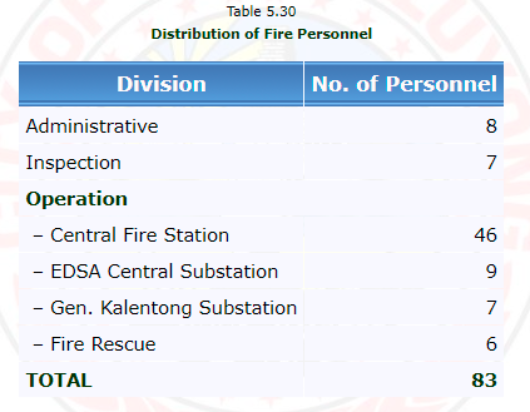
This gives a Fireman-population ratio of 1:3,355
Size and area coverage of fire substations are shown in Table 5.31.
C. Fire Trucks and Rescue Equipment
There are only three (3) fire trucks available for operation in the city. This is augmented by three (3) more water tankers and another three (3) water pumpers during fire emergencies. Two (2) ambulances for rescue operations are in stand-by. Other fire facilities include mobile radios for communication purposes.
Compared to the previous years, the current quantity of fire trucks has decreased from the recorded four (4) in 2000 to a three (3) this year. This leaves one fire truck for each sub-station. (see Table 5.32)

D. Fire Hydrants
A total of 78 fire hydrants distributed all over the city supplement the firefighting facilities. Of these, 60 are operational and 16 as non-operational.
Fire Incidence Statistics
With figures of fire incidences for years 2000-2002, fire occurrence averages at 254.33 annually. This seems to be a high frequency considering the size of the city. However, it can be attributed to the proliferation of informal settlements in various barangays.
These fire incidences are mostly rubbish and structural in nature, with origins varying from electrical, cigarette butts, LPG (Tank/Stove) to unknown sources as can be seen in Table 5.33.
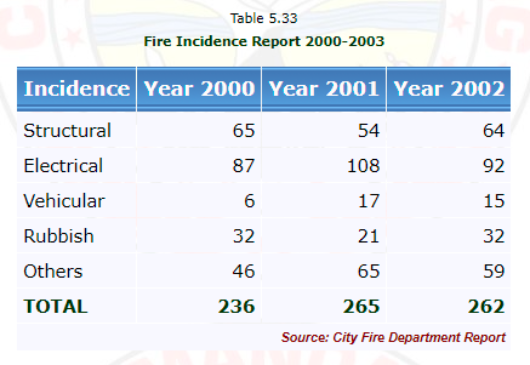
Fire Safety Prevention Measures
A. Fire Safety Inspections
One measure to prevent fire occurrences is the continuous conduct of fire safety inspections in different establishments in the city. As shown in Table 5.31, inspections conducted in year 2000 increased by 1.78% from 1999 inspections. Fewer establishments in year 2000 were found to have deficiencies in fire safety requirements and subsequently recommended for correction and improvement. Consequently, a total of 301 Fire Safety Inspection Certificates were issued, a 24.38% increase compared to the 242 certificates issued in 1999.
B. Community Relations
Another preventive measure is maintaining Community Relations. As a result, more fire drills were conducted and more volunteers trained in this year as can be seen in Table 5.32. At the same time, 300 empty drums were distributed to serve as stand-by water containers in cases of emergencies.
Problems and Needs
Mandaluyong City is adequately provided with fire station facilities considering that the three (3) existing fire substations located as shown in Map 55 have overlapping radii of services.
Based on standards, one fire substation should be within a radius of 2.5 km., 5 km. and 10 km. from commercial-industrial areas, medium to high density residential areas, and low density residential areas, respectively. The city is mostly medium to high density residential with commercial strips and has a total land area of 11.25 sq. km., well within the coverage of one fire substation.
In addition, the city is adequately served with roads such that the ideal travel time of two (2) minutes from the station to the fire can be achieved. There are, however, certain problems that have to be addressed for a more efficient fire fighting service.
A. Delayed Response
Despite adequacy of roads and relatively short distances between fire substations and the sites on fire, there are instances when fire trucks are delayed due to traffic congestion in some areas and the negative attitude of drivers particularly of public utility vehicles to pull over the side of the road and give way to fire trucks and other vehicles responding to the emergency calls. An additional of one (1) to two (2) minutes of travel time would certainly result to greater damages which road users must be made aware of.
B. Preventable Causes of Fire
Based on the Fire Incidence Report, causes of most fires such as discarded glowing cigarette butts, leaking gas tanks, and faulty electrical wiring, are preventable in nature and resulting from carelessness, negligence, or ignorance of the individual who caused the fire.
C. Very Low Fireman-Population Ratio
By standards, the fireman-population ratio should be at least 1 : 500 for urban/metropolitan areas. In actual, the City of Mandaluyong has a ratio of 1 : 3,355 which means that one fireman has 3,355 people under his protection, almost seven (7) times that of the standard.
D. Insufficient Fire Fighting Facilities
By standard area coverage, the existing three substations are more than sufficient to serve the entire city. However there are factors that suggest the need for additional fire substations, to wit;
Existing substations are not sufficient to accommodate increase in fire-fighting personnel and apparatus/fire trucks Influx of people and increase in building density as a consequence of intensification of land uses/activities pursuant to the approved Comprehensive Land Use Plan of the City.